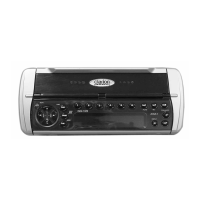7
XMA1
87.5 to
108 MHz
AM
FM
Frequency
spacing
Frequency
range
Frequency
spacing
Frequency
range
Initial Setting
(U.S. standard)
New Setting
(outside U.S.)
10 kHz
530 to
1,710 kHz
200 kHz
87.9 to
107.9 MHz
9 kHz
531 to
1,629 kHz
50 kHz
Radio Operation
FM Reception
For enhanced FM performance the
®
tuner includes sig-
nal actuated stereo control and Multipath noise reduction circuits.
Listening to the Radio
1) Press the FUNC button 2 and select the radio mode. The radio
turns on.
2) To tune in a preset station, first press the “BAND” button $ and
select FM1, FM2, FM3 or AM.
The “BAND” changes as follows each time the “BAND” button is
pressed:
FM1 ➜ FM2 ➜ FM3 ➜ AM ➜ FM1
3) Use the Preset buttons 5 to select the desired station.
Mute
Use this function to turn off the sound immediately.
Press the MUTE button !. The sound turns off and “MUTE” ap-
pears on the display. Press the MUTE button again to cancel the
mute mode.
Seek Tuning
1) Press the “BAND” button $ and select the desired band.
2) Press the SRCH Left or Right button @. Seek tuning automati-
cally stops when a station is found.
Manual Tuning
1) Press the “BAND” button $ and select the desired band.
2) Press the “BAND” button again for more than 2 seconds. “MANU”
lights in the display and the manual tuning mode is set.
3) Use the SRCH Left and Right buttons @ to tune in the desired
frequency.
Presetting Stations
A total of 24 stations can be preset, 6 each for the FM1, FM2, FM3
and AM bands.
Note:
• When a station is preset, the station previously stored in the memory
at that position is cleared.
Presetting stations manually
1) Press the “BAND” button $ to select the band at which to store
the station.
2) Use the SRCH Left and Right buttons @ to tune in the station to
be preset.
3) Press the Preset button 5 at which you want to store that station
for at least 2 seconds.
Auto store function (Automatic Station Store)
1) Press the “BAND” button $ to select the band at which to store
the stations.
2) Press the AS button 6 for at least 2 seconds. Stations with good
reception are automatically stored at Preset buttons 5 1 to 6.
∗ If there are fewer than 6 stations with good reception, the stations previ-
ously stored at the remaining buttons are not cleared.
Preset Scanning (Preset Station Scan)
When the PS button 6 is pressed, the preset memory numbers
flash and the stations are tuned in for 7 seconds each in the order in
which they were stored. Press the PS button again to cancel the
preset scanning mode.
Instant Station Recall (ISR) Function
This function allows you to recall a specific radio station from any
mode. Use it to find stations quickly when you want to hear specific
information (such as traffic announcements) while driving. The ISR
station is set to 87.9 MHz upon shipment from the factory.
Setting the ISR station
1) Press the FUNC button 2 to select the radio mode.
2) Tune in the station to be set as the ISR station.
3) Press the ISR button ¥ for more than 2 seconds to store that
station in the memory as the ISR station.
Recalling the ISR station
Press the ISR button ¥ from any mode. “ISR” appears on the dis-
play and the set station is tuned in. To cancel, press the ISR button
again.
Area Change Function
Use this to listen to the radio outside of the United States.
Switchable frequency spacing
This boat stereo is initially set to tune in frequency intervals of 10
kHz for AM and 200 kHz for FM, the standard calibrations in the U.S.
When using the unit outside the U.S., use the following procedure to
switch the frequency steps and frequency range:
1) Turn the power on and set the tuner mode.
2) Keep the “BAND” button $ pressed and while pressing the but-
ton, press the SRCH Left button @.
3) Release the buttons.
This procedure changes the factory setting to 9 kHz steps for AM
and 50 kHz steps for FM, the standard calibrations for countries
other than the U.S.
To change the AM/FM setting back to the U.S. standard frequencies:
1) Set the tuner mode.
2) While pressing the “BAND” button $, press the SRCH Right but-
ton @.
3) Release the buttons.
Your boat stereo will once again be calibrated to receive standard
U.S. transmissions.
The chart below lists the frequency specifications for the U.S. and
other countries.

